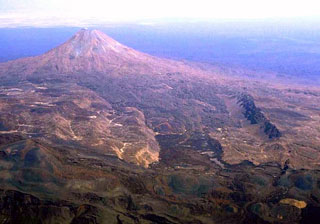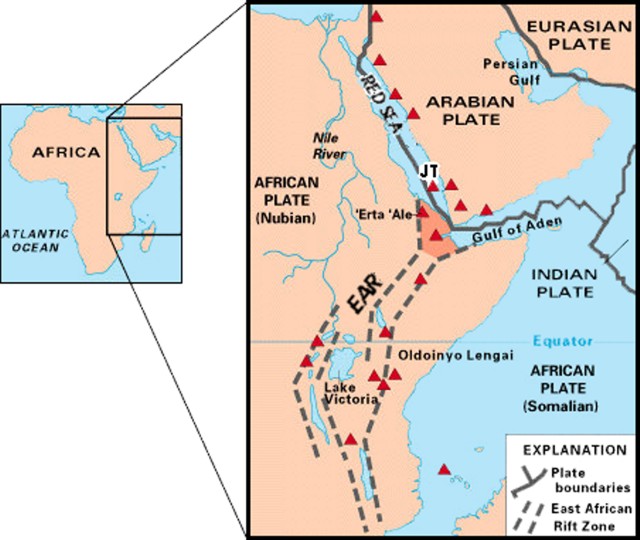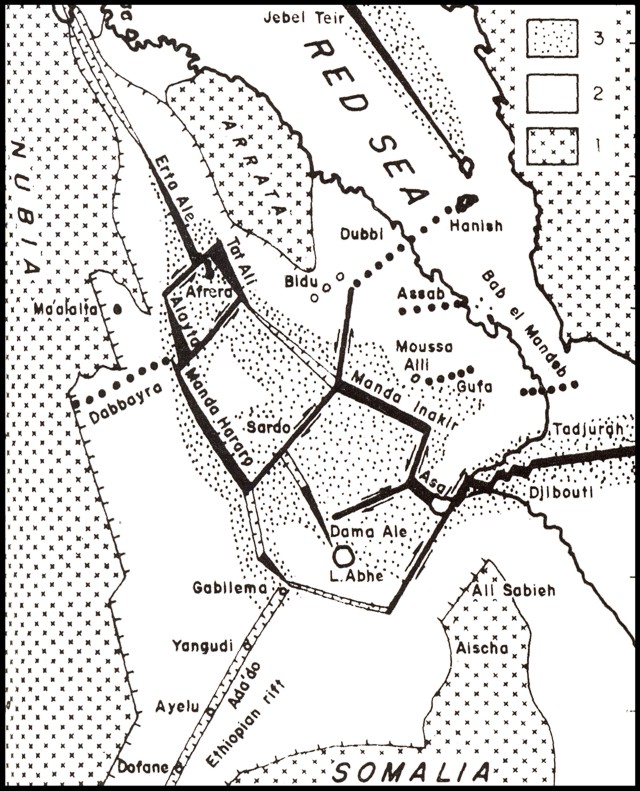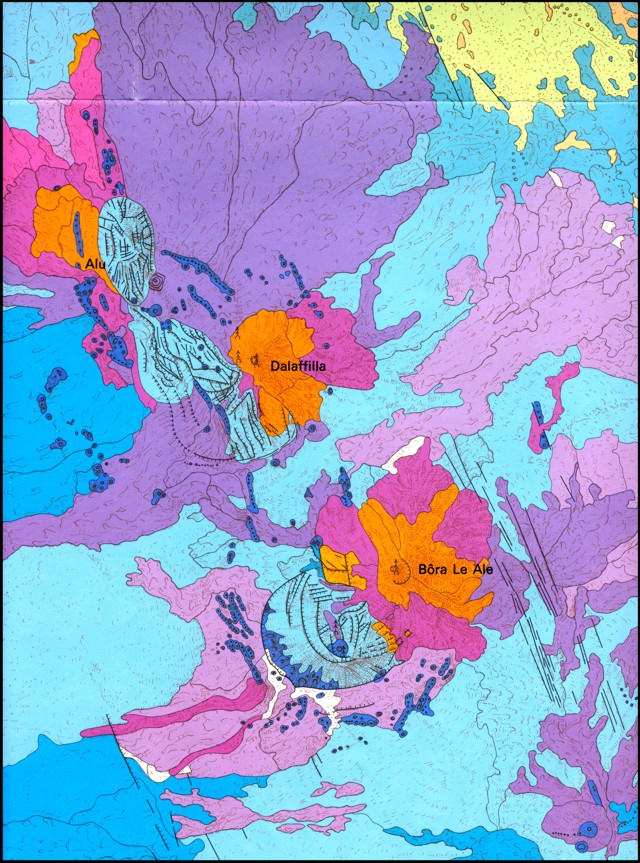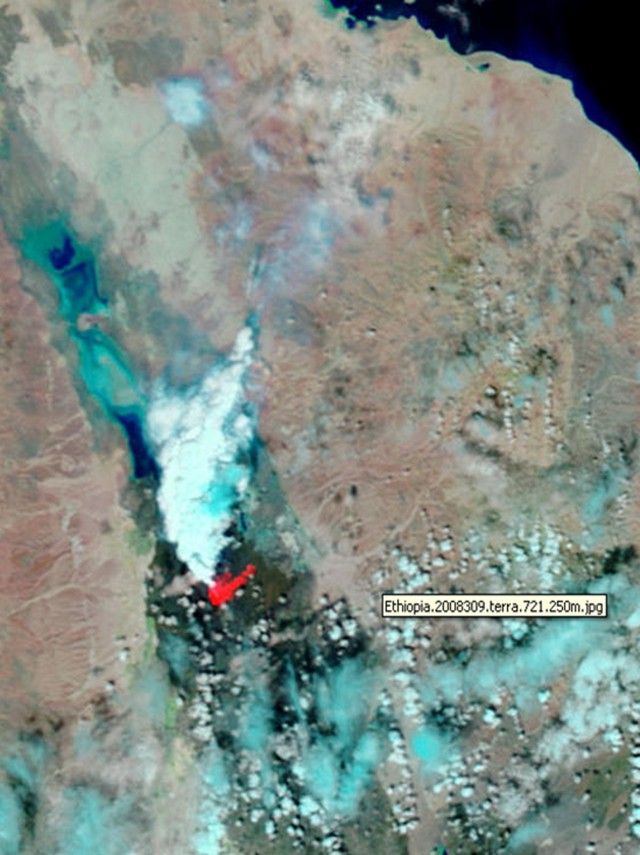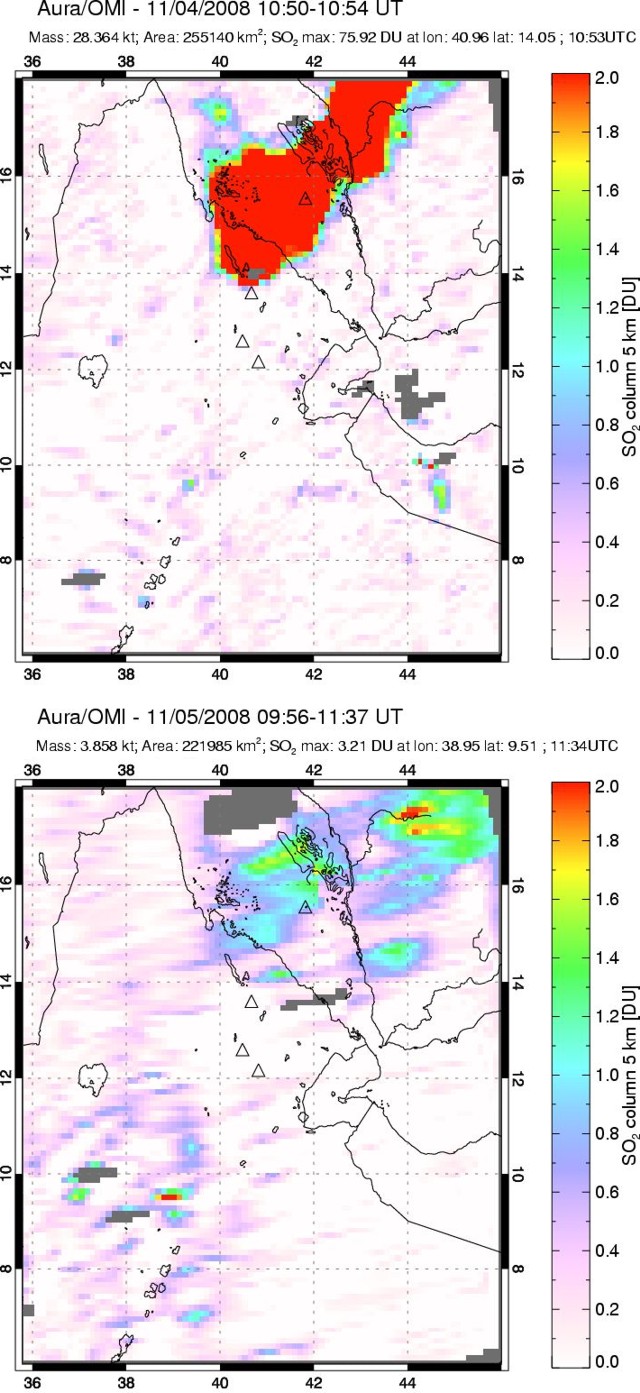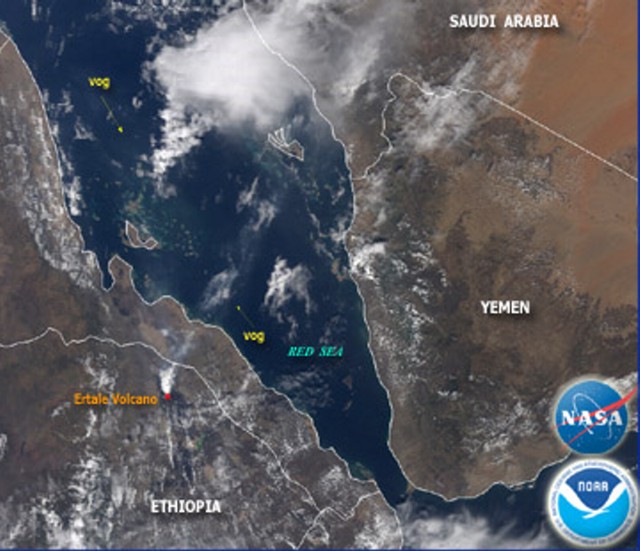Report on Alu-Dalafilla (Ethiopia) — October 2008
Bulletin of the Global Volcanism Network, vol. 33, no. 10 (October 2008)
Managing Editor: Richard Wunderman.
Alu-Dalafilla (Ethiopia) Satellite data reveals rift axis lavas erupted in November 2008
Please cite this report as:
Global Volcanism Program, 2008. Report on Alu-Dalafilla (Ethiopia) (Wunderman, R., ed.). Bulletin of the Global Volcanism Network, 33:10. Smithsonian Institution. https://doi.org/10.5479/si.GVP.BGVN200810-221060
Alu-Dalafilla
Ethiopia
13.793°N, 40.553°E; summit elev. 578 m
All times are local (unless otherwise noted)
During November 2008, lava extruded from fissures and by 8 November covered a heavily faulted zone spreading over about 15 km2 in the Afar (or Danakil) depression. This eruption is ~ 25 km NW of Erta Ale volcano, in the Erta Ale volcanic range (figure 1). The range lies along the axis of the the NW-trending Danakil depression, a hot, arid, and desolate rift basin with a floor in places ~ 100 m below sea level. Going NW along the rift from Erta Ale, the named volcanic centers include Bora Le Ale, Dalaffilla, Alu, and Gada Ale. The tectonically active area (figure 2) has extremely low population density and scientists' field reports have yet to emerge. Prior to this event, there were five eruptive episodes in the region since 1967, three of those since September 2005 (table 1).
Table 1. A synopsis of known Afar region eruptions since 1967, including the case at hand, Dalaffilla. Compiled from Smithsonian volcano reports (CSLP and SEAN are Smithsonian BGVN predecessors).
| Volcano (Country) | Location (with respect to Erta Ale) | Eruption dates | Comment |
| Erta Ale (Ethiopia) | -- | 1967-present | Active lava lake(s) ongoing through present [eg. CSLP 22-71, BGVN 33:06]. |
| Ardoukôba (Djbouti) | 300 km SE | 07-14 Nov 1978 | Ardoukôba (Asal rift) produced small cinder cone and lava flows on rift floor [SEAN 03:11, 03:12]. |
| Dabbahu (Ethiopia) | 113 km SE | Sep 2005 | Short-lived explosive eruption with apparent dome in the deep portion of the elongate crater (Also see Wright and others, 2006) [BGVN 30:09]. |
| Manda Hararo (Ethiopia) | 160 km S | 12 Aug-Sep 2007 | Lava flows, numerous small spatter and scoria cones; occasional flames. Recent fault movement. Located in the Karbahi graben between the settlements of Semera and Teru [BGVN 32:07]. |
| Jebel at Tair (Yemen) | 250 km NNE | 30 Sep 2007-01 Jan 2008 | An explosive and effusive eruption of lava on inhabited island in the S-central Red Sea (evacuation and fatalities) [BGVN 32:10, 32:04]. |
| Dalaffilla (Ethiopia) | 25 km NW | 03 Nov 2008 | This is the first BGVN report on either Dalaffilla or adjacent Alu volcanoes (mainly satellite data available thus far in late November 2008). |
The conical summit of Dalafilla (which means "cut neck" in the Afar language) lies about 6 km SE of the center of the elongated summit horst of Alu (figure 3). The current eruption took place from vents between these two rift-axis centers, both of which have extensive vents, fissures, and faults trending along the rift axis. Determination of the provenance of flank vents can be problematical in a rift setting such as this that displays adjacent, but slightly offset elongated, rift-parallel volcanism. Preliminary analysis of satellite imagery suggests that the lava flows originated from fissures or vents extending downslope from the sides of the Dalafilla volcanic center.
Thermal radiance remained significant into at least early December. Available news reports claimed the area of new lavas as 20-fold larger than they turned out to be, casting doubt on their other descriptions of the eruption. Still, the plume reached 13-16 km altitude and delivered ~ 10,000-20,000 metric tons of SO2 into the atmosphere.
Geolocation errors. During the early phases of this eruption, while attempting to determine the source volcano, it became apparent that the GVP coordinates for Alu were displaced towards the E in the area with the new flows. Inaccurate volcano locations can result from older, imprecise, base maps, especially in remote areas. They may also be caused by the lack of a global datum, even when precise maps are available. More recent satellite imagery and mapping techniques are gradually improving the situation, and the location for Alu has been corrected (see figure 7 below).
Eruptive activity. Charles Holliday found Meteosat-9 infrared (IR) satellite data to constrain the eruption's start on 3 November 2008. He went on to estimate the plume's maximum height, which first occurred about one hour after any cloud was first visible. He had images every 15 minutes and found no sign of an eruption cloud as late as 1245 UTC (0945 local time). This was followed by a small initial cloud appearing at 1300 UTC, which then grew to larger clouds blowing E. Looking at the Meteosat-7 IR data, Holliday found the eruption at around 1350 UTC.
Holliday determined the sequence of coldest pixels (table 2). He found the coldest pixel of the set in an image representing Meteosat-9 at 1350 UTC, about -73°C, and by comparing an atmospheric sounding made over Abha, Saudi Arabia inferred a maximum plume height of 15.7 km. The coldest pixel, -64°C, was in a Meteosat-7 IR image from 1350 UTC. Comparison with the same OEAB sounding as above obtained a maximum plume height 13.5 km.
Table 2. Times and coldest pixels related to the Dalaffilla eruption seen in Meteosat-9 IR satellite data on 3 November 2008. The last two rows include ancillary data and results used to describe the coldest pixels on the Meteosat-9 and -7 IR data. The data were used to estimate the maximum cloud height (reached around 1400 UTC). The Meteosat-7 IR data for other times was not available but the one entry (at 1350 UTC) was described as the coldest. Courtesy of Charles Holliday.
| Time (UTC) on 3 Nov | Coldest pixel from IR image Meteosat-9 (Meteosat-7) |
| 1300 | -66°C (?) |
| 1315 | -73°C (?) |
| 1330 | -71°C (?) |
| 1345 | -71°C (@1350 UTC, -64°C) |
| 1400 | -73°C (?) |
| 1415 | -73°C (?) |
| 1430 | -71°C (?) |
| Atmospheric sounding at 1200 UTC from Rawinsonde station at Abha, Saudi Arabia, WMO 41112, OEAB; located ~545 km NNE (at 18.24°N, 42.66°E). Equatorial subpoints (IR resolution): Meteosat-7, 57.5°E (5 km); Meteosat-9, 0° (3 km). | |
| Conclusion (Plume top estimates): | Meteosat-9, 15.7 km altitude at 1315 UTC |
| Meteosat-7, 13.5 km altitude at 1350 UTC | |
Activity could also be identified in a MODIS (Moderate-resolution Imaging Spectro-radiometer) image from 4 November (figure 4), a composite using three of 36 available bands, from orange-red and into the IR (bands 7-2-1). Although the areas of high thermal flux may lack detail on this 250-m resolution image, that area lacks the SW-directed spur seen on some later photos.
In a 6 November message Simon Carn noted that in terms of sulfur dioxide (SO2), the November eruption generated a large cloud. As detected by the Ozone Monitoring Instrument (OMI) and the Atmospheric Infrared Sounder (AIRS), the cloud initially drifted E over the Arabian peninsula. The cloud was clearly linked to the eruption because MODIS/MODVOLC data from the Hawai'i Institute of Geophysics and Planetology (HIGP) Thermal Alerts System confirmed an extensive hotspot.
A total of 0.1-0.2 Tg (tetragram) of SO2 (1 Tg = 1012 g = 109 kg = 106 Tons) was measured in the eruption cloud by OMI at ~ 1100 UTC on 4 November, by which time the SO2 cloud had reached S Iran. The cloud had dissipated and moved east by the next day (figure 5). On 6 November, the plume appeared the same or even stronger than the one the previous day. But on subsequent days the plumes became much smaller.
NASA's Earth Observatory first discussed this phase of the eruption with reference to a MODIS image captured on 4 November. Owing to an extensive white plume, the analysts could not make out the lava field, but they saw widespread haze towards the N (figure 6) that they and NOAA analysts interpreted as vog (volcanic smog, which results from volcanic gases such as SO2 mixing with water vapor and oxygen in the presence of sunlight).
Matthew Patrick of the USGS processed and provided a nighttime ASTER image, taken 8 November 2008 at 1942 UTC, showing the lava flow between Dalaffilla and Alu volcanoes, and Simon Carn superimposed it on Google Earth imagery (figure 7). Carn noted that the underlying pre-eruption Google Earth imagery shows relatively youthful cinder cones and lava flows in this region.
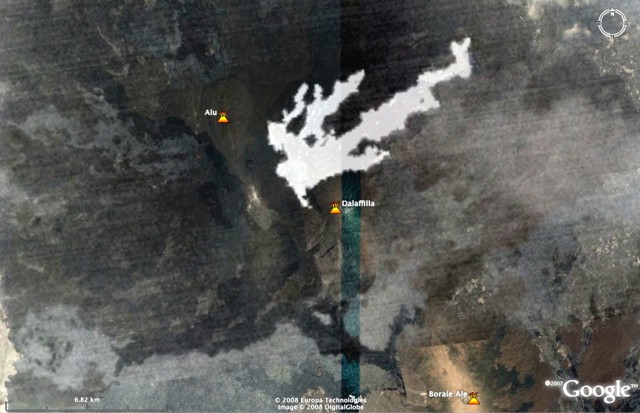 |
Figure 7. The pattern of high thermal flux in the Dalaffilla area superimposed on a Google Earth map with the corrected placemark locations. Courtesy of Matt Patrick and Simon Carn. |
Patrick made these preliminary assessments based on 90-m resolution thermal infrared (TIR) data from 8 November, and on later visible data. The registration between these data sets was imperfect in the E-W direction. The lava flow comprised a multi-lobed field from a fissure or fissure system. Flow direction was transverse to the rift axis, to the NE. The flow field on 8 November was 9.3 km long by ~ 3.0 km wide, and its surface area was 14.9 km2. The flows originated from NW-trending fissures extending over a distance of 2.7 km.
Patrick later noted that the main channel originated along a fissure that cut the surface near a prominent older cinder cone. The cone was visible in the pre-eruption Google Earth imagery. The geologic map by Barberi and Varet (1970), shows similar NW-SE-trending eruptive fissures of likely Holocene age (cutting the youngest basalts) in this same area between Dalafilla and Alu (figure 3).
A second Earth Observatory report featured one ASTER image made before the eruption, and another several weeks after on 16 November (figure 8). That figure presents one of the better images for inspecting the upper lava flow field (which appears dark in the image).
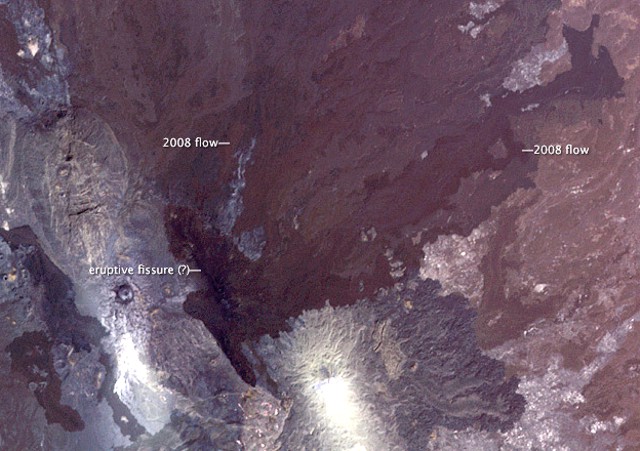 |
Figure 8. Dalaffilla (bottom center) and Alu (ellipse, left center) volcanoes and the new lava flow field that flowed downslope to the NE. Courtesy of NASA Earth Observatory. |
MODVOLC Thermal Alerts. In harmony with the IR data above, satellite thermal alerts (anomalies) measured by the Hawai'i Institute of Geophysics and Planetology (HIGP) Thermal Alerts System swelled. For years before 3 November 2008 they stood at zero. On 3 November they rose to 148 pixels. On passes the next day the number of thermal-alert pixels had dropped and continued to descend (at 0735 UTC, 31 anomalies; at 1040 UTC, 18 anomalies). Thereafter through at least early December, many days had 1 to 10 thermal alert pixels. On occasional days, particularly during 5-17 November, as many as 26 appeared. As of early December, the anomalies were still around several pixels. Spatially, these anomalies typically overlay and extended beyond the flow field.
References. Barberi, F., and Varet, J., 1970, The Erta Ale volcanic range (Danakill depression, Northern Afar, Ethiopia): Bull Volc., v. 34, p. 848-917.
Barberi, F., and Varet, J., 1972, Geological map of the Erta Ale volcanic range (Danakil depression, Northern Afar, Ethiopia): Centre National de la Recherche Scientifique (France) and Consiglio Nazionale delle Ricerche (Italy), approximate scale, 1:100,000, includes explanatory text, ISBN 2-222-01521-9.
Barberi, F., and Varet, J., 1975, Volcanological research in Afar (L.R. Wager Prize Lecture): Bull. Volc., v. 39, no. 2, p. 5-13.
Wright, T.J., Ebinger, C., Biggs, J., Ayele A., Yirgu, G., Keir, D., and Stork, A., 2006, Magma-maintained rift segmentation at continental rupture in the 2005 Afar dyking episode: Nature, v. 442, p. 291-294 (20 July 2006), doi:10.1038/nature04978.
Wood, J., and Guth, A., 2008, East Africa's Great Rift Valley: a complex rift system: Geology.com (URL: http://geology.com/articles/east-africa-rift.shtml)
Geological Summary. The summit region of Alu, ~5 km NW of the Dalafilla stratovolcano, is an ellipsoidal volcanic horst, elongated NNW-SSE, and formed primarily of older basaltic lava flows. Recent fractures along the axis of the Erta Ale range cut the main horst of Alu and areas to the SSE. Fumarolic activity is located on the numerous parallel faults. Fissure vents west of the horst have fed silicic lava flows, and voluminous youthful basaltic lava flows to the east extend north as far as Lake Bakili. Dalafilla, also referred to as Gabuli, is a steep-sided cone that rises 300 m above surrounding lava fields due to extrusion of viscous, silicic lava flows. Basaltic lava flows from regional fissures surround the volcano. Fumarolic activity occurs in the 100-m-wide summit crater and has weathered surrounding lava flows. The first historical eruption of Alu-Dalafilla took place in 2008, when lava flows from vents between the two edifices traveled NE.
Information Contacts: Jacques Varet, Geoscience for a Sustainable Earth, BRGM 3, avenue Claude-Guillemin, 45060 Orléans cedex 02, France; Charles Holliday, U.S. Air Force Weather Agency (AFWA)/XOGM, Offutt Air Force Base, NE 68113, USA; Matthew R. Patrick, Hawaiian Volcano Observatory (HVO), U.S. Geological Survey, PO Box 51, Hawai'i National Park, HI 96718, USA (URL: https://volcanoes.usgs.gov/observatories/hvo/); Simon Carn, Dept of Geological and Mining Engineering and Sciences, Michigan Technological University, 1400 Townsend Dr., Houghton, MI 49931, USA (URL: https://so2.gsfc.nasa.gov/); Hawai'i Institute of Geophysics and Planetology (HIGP) Thermal Alerts System, School of Ocean and Earth Science and Technology (SOEST), Univ. of Hawai'i, 2525 Correa Road, Honolulu, HI 96822, USA (URL: http://modis.higp.hawaii.edu/); Gezahegn Yirgu, Dept of Earth Sciences, Addis Ababa University, PO Box 1176, Addis Ababa, Ethiopia; NASA Earth Observatory (URL: http://earthobservatory.nasa.gov/).

